Structure Formation
An analysis of electronic superimpositions in Stockhausen’s “Solo”
The following article is an abridged version of a paper written in partial fulfilment of the requirements for the degree of Doctor of Musical Arts at the University of Toronto. The full paper includes a discussion of diffusion and a comparative musical analysis of a hypothetical score with an actual performance. The current text has been edited for publication in eContact! 16.3.
Karlheinz Stockhausen, in his work Solo für Melodieinstrument mit Rückkopplung, Nr. 19 (Solo for Melody Instrument with Feedback), sought a new conception of form, a “memory” form in which a feedback of musical ideas would interact in real time. The creation of the score itself follows an interactive process whereby the instrumentalist extracts fragments from Stockhausen’s pre-composed musical material and patches them together anew. A performance of Solo incorporates a variable-length tape delay and feedback system that superimposes recorded material and plays it back live. It is this Strukturbildung (structure formation of electronic superimpositions) that will be the focus of analysis.
I imagined a music in which — as in life — at certain moments splinters or figures of memory simultaneously superimpose audibly, to which the soloist could play commentaries, supplements, something new: a music in which one senses that the player is “thinking out loud”, and in which one experiences the creation and dissolution of multi-layered processes, as they take place. Only when music makes us aware of the polydimensional thinking and experiencing and of the process of the structure formation — instead of an object — a higher level of composing for a soloist would be achieved. (Stockhausen 2002, 50)
Although Solo appears to be an open-form work, electronic superimpositions manifest structures which function at a macro-formal level, whereas content (and a number of other parameters) shape form at a micro-formal level. Thus, Solo has a definite fixed form: a structure of electronic superimpositions that Stockhausen systematically conceives and distributes across the six Versions of the work.
Stockhausen began sketching Solo in 1964, completed the work in March and April of 1966, and made final revisions in 1969. The score is dedicated to his friend Alfred Schlee, the director of the Vienna branch of Universal Edition (Stockhausen’s publisher at the time), and the work was commissioned by NHK (Nippon Hoso Kyokai) of the Japanese Radio Broadcasting Services. In a concert on 25 April 1966 at NHK in Tokyo, two versions of Solo were premiered — a version for trombone and another for flute 1[1. The soloists were Yasusuke Hirata (trombone) and Ryū Noguchi (flute). The assisting technicians were Akira Honma, M. Nagano, Shigeru Satō and Wataru Uenami.] — along with a premiere of Stockhausen’s electronic composition Telemusik.
Stockhausen’s original concept for Solo was, in essence, a live electronic version of his groundbreaking composition Gesang der Jünglinge, although in this case the montage process would take place during the performance and the soloist would spontaneously interact with the electronic superimpositions produced by the feedback system.
In the solo music to date, one thing had always succeeded another; the temporal span was conceived and heard as a line. What I had in mind, however, were musical spaces, in which the order of events is not fixed, but rather in which it is possible to move in all directions, similar to the way in which a mobile sculpture is viewed. The spontaneity of the playing and the acoustical “accumulation” and “verticalisation” of musical moments should make it possible to experience this spatial awareness. (Stockhausen 2002, 50–51)
Ultimately, Stockhausen’s intentions proved too difficult to realize in actual performance. Even for the premieres, Stockhausen allowed the instrumentalists to prepare worked-out written versions. The revised score of 1969 (the source of our analysis) incorporates these modifications and is the score in use today.
Stockhausen likens Solo to several of his own works from the same period: Plus-Minus, Momente and Mikrophonie I (Stockhausen 2002, 50). The score of Plus-Minus (1963), Stockhausen’s first process composition, comprises seven “symbol pages” and seven “note pages”; instructions govern the manipulation of a number of different parameters (usually, but not always, consisting of seven permutations), including types of rests (short, medium, or long) and types of superimposition. Momente (1962–69) consists of thirty interchangeable sections (“moments”) that Stockhausen categorizes according to their musical content as “M moments” (monophony / heterophony), “K moments” (homophony), and “D moments” (polyphony). Mikrophonie I (1964–65), preceded by Mixtur as Stockhausen’s first live electronic work, incorporates the concepts of moment form and process composition with live electronics. All these works share many similarities with Solo; in fact, they are closely linked and in many respects extensions of each other.
Solo is preceded by Terry Riley’s Music for the Gift (1963) as the first composition to employ a tape delay and feedback system; however, Riley’s composition lacks a score, thus Solo is the first such composition employing a score. Riley began working with tape loops in the 1950s, his experiments culminating in the “Time-lag Accumulator” (a multifunctional tape delay and feedback system designed for live performance). In 1961, the San Francisco Tape Music Centre was founded; in addition to Terry Riley, its members included Pauline Oliveros and Steve Reich. In 1966, Oliveros composed I of IV (no score), employing an “interactive performable system involving tone generators, tape delays, and amplifiers to produce combination tones, repetitions, layering of sounds, and different kinds of reverberation” (Chadabe 1997, 77). Working with closed tape loops, Steve Reich pioneered the technique of phase shifting with his composition It’s Gonna Rain (1965). Other notable works of the time include John Cage’s Rozart Mix (1965), in which the performers “make, repair, change, and play tape loops” (Ibid., 75) using at least eighty-eight closed tapes loops on at least twelve tape machines, and Alvin Lucier’s tape composition I am Sitting in a Room (1969). Cage incorporates the superimpositions of the various tape loops into his processes of indeterminacy and Lucier exploits the technical weakness of tape recording as a means of exploring a compositional use of resonant frequencies. Although Stockhausen’s use of tape delay and feedback was not novel for its time, his approach was: he was the first composer to attempt to exert compositional control over electronic superimpositions in a sophisticated manner.
Stockhausen cultivated a sense of mysticism and enigma in many of his compositions; this, along with the complexity of Solo, has led to misconceptions about the work that I will attempt to elucidate. I will begin with an overview of the mechanics of Solo, including an explanation of the feedback system, and then move on to a categorization and analysis of electronic superimpositions and techniques in an attempt to arrive at a systematic organization of electronic form for Solo.
Overview
In this section, I will focus on the attributes of Solo most pertinent to our analysis, including a discussion of instrumentation, formal organization, score generation, the role of the instrumentalist and assistants, and the feedback system.
Instrumentation and Electronics
For a performance of Solo, Stockhausen calls for an instrumentalist (on any melody instrument) and four assistants. Three assistants respectively control the microphone levels, feedback levels and output levels, while the fourth assistant controls the change of playback heads (although the third assistant may double on this task).
Stockhausen prescribes four different timbres to the instrument: N (normal), I, II and III; arrows between symbols signify that the performer should attempt to transition between timbres. The instrumentalist has several options in determining the four specific timbres, such as the use of various techniques on the same instrument, the possibility of selecting other instruments (presumably of the same family) or the use of electronic means.
In a version for a flutist, the following timbres were used (Stockhausen 1969, 13):
- N — flute;
- I — piccolo and flute with emphasized overtone content, and recorder;
- II — flute with simultaneously hummed tones;
- III — alto flute (in transitions such as N → III, the flutist on the transverse flute attempted to imitate increasingly, with the aid of labials, the timbre of the alto flute).
As well, Stockhausen provides three further timbral indications: Sehr Geräuschhaft (very noisy), Etwas Geräuschhaft (somewhat noisy) and Geräuschhaft (noisy). In addition to extended techniques such as overblowing, key clicks and increased bow pressure, Stockhausen again permits the use of electronic means (e.g., noise modulation). Thus, Solo is scored for a single melodic instrument or group of instruments, with the possibility of the live processing of sound.
The Central Role of the Number Six
The number six is central to the organization of the formal structure of Solo and to the systemization of certain temporal elements. The score consists of six pages of musical notes and six Formschemen (Form Schemes) labelled “Version” I–VI. Each page of musical notes consists of six systems (or in the case of one of the pages, six sets of systems grouped in pairs). Additionally, each Form Scheme comprises six “cycles” (sections) labelled from A to F, and each cycle is further divided into a number of “periods” (subsections) ranging between six and eleven. In this case, the number six functions as the initial operand of a simple mathematical operation to generate a discrete set of numbers:
6+1=7+1=8+1=9+1=10+1=11
Periods range in length from 6 to 45.6 seconds. Finally, our analysis will reveal that Stockhausen categorizes electronic superimpositions into six pattern types and allocates each pattern type to one of the six cycles. Thus, the number six plays an important generative role and is ubiquitous in the systematic creation of structure.
Form Schemes, Interpretation Schemes and the Preparation of a Version
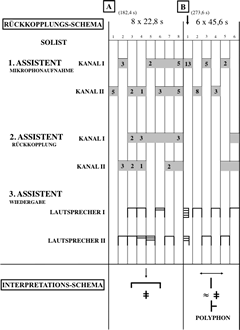
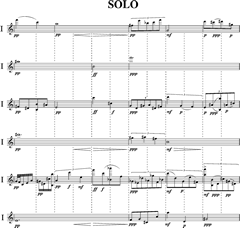
In addition to specifying the number and duration of periods in every cycle, each form scheme consists of a Rückkopplungs-Schema (Feedback Scheme) and an Interpretations-Schema (Interpretation Scheme). The Feedback Scheme instructs the assistants to open and close their respective potentiometers at precise times (Fig. 1). For the first and second assistants, shaded boxes indicate that potentiometers must be opened. The numbers within the boxes specify the number of “perforations” (rapid closing and reopening of the potentiometers) to be performed per period. For the third assistant, a horizontal line indicates that potentiometers must be opened during a period (horizontal lines stacked vertically indicate the number of superimposed layers); the absence of a line indicates that potentiometers must be closed. The Interpretation Scheme provides indications (mainly consisting of symbols which Stockhausen defines in the score notes) for the instrumentalist to follow in the preparation of a performance score.
In the preparation of a Version, Stockhausen instructs the instrumentalist to select one Form Scheme and to assign one page 2[2. The pages of musical notes are unnumbered in the score of Solo.] of musical notes to each cycle. The instrumentalist then “interprets” (extracts) systems, “parts” (sections of systems separated by bar lines) or “elements” (individual notes, individual grace notes or groups of grace notes) from the original musical material and inserts these components (for the most part, interspersed with rests of varying length) onto a new musical score, which will then serve as the actual performance score (Fig. 2).
This collage-like procedure follows a set of detailed written instructions provided at the beginning of the score that defines the following parameters: page interpretation, musical component interpretation, method of interpretation, duration of pauses between parts and elements, and acoustic 3[3. I will use the term “acoustic” throughout to refer to the live sound produced by the instrumentalist, although, strictly speaking, the instrumentalist could perform the work on an electronic instrument, or the sound of the instrument could be amplified or processed electronically.] entry patterns. Stockhausen assigns a set of symbols or indications to each parameter and they appear in the Interpretation Scheme. Since the explanatory notes in the score delineate the parameters of the Interpretation Scheme in a concise manner, what follows is only a brief summary of pertinent information.
The page interpretation parameter defines which page or pages act as the source for the instrumentalist’s extraction process. While creating the page of musical notes that correlates to a specific cycle, the instrumentalist will always interpret musical components from the page of notes which they originally chose for a particular cycle (the source page), but according to the page interpretation symbol assigned to the cycle, the instrumentalist may also include components from the previous page, the following page or both the previous and following pages.
The musical component parameter instructs the instrumentalist to extract either entire systems, parts, elements or combinations thereof. The method of interpretation involves selecting musical components that are either the same, different, contrasting or a combination thereof (based on register, pitch, dynamics, timbre, duration, articulation, etc.).
According to the pause duration parameter, the instrumentalist will always intersperse parts and elements with either “relatively long pauses”, “medium-long pauses”, “short pauses” or combinations thereof, but consecutive entries of systems are not separated by pauses.

The final interpretation parameter, the acoustic entry pattern, stipulates that the entry of parts and elements should obey one of the following three textural structures or a combination thereof: Polyphon (polyphonic), Akkorde (chordal) or Blöcke (in blocks). Stockhausen illustrates the characteristic structure of two of these indications (Fig. 3); however, he does not illustrate the Akkorde texture, instead defining it as a structure in which entries should be synchronous and layers should produce as many chords as possible.
The preparation of a score for a Version of Solo is a formidable task. In order to achieve the characteristic features of each acoustic entry pattern, the instrumentalist must map out and take into consideration all the electronic reiterations that the tape delay and feedback system will produce and attempt to create superimpositions that adhere to Stockhausen’s guidelines. Although Stockhausen’s directions are extremely methodical, they are not exhaustive, and as a result certain inconsistencies and conflicts arise which force the soloist to make decisions outside the scope of the Interpretation Scheme.
The Role of the Instrumentalist and Assistants
The instrumentalist exercises the most significant influence over musical material, but the assistants also play a role in shaping musical content and form, although to a lesser extent. The first and second assistants must decide at which points to “perforate” the electronic superimpositions. Stockhausen instructs them to monitor the feedback with earphones in order to create “variations” of periods by leaving out single tones from melodic sequences, “puncturing” held tones, or, in certain instances, deciding to omit perforations altogether to allow held tones to sustain for an entire period or longer. The third assistant, in addition to opening and closing potentiometers at the precise moments indicated in the Feedback Scheme, must constantly regulate output levels (reacting to the instrumentalist and attempting to achieve an extreme differentiation in sound output), diffuse the sound ad lib. and interpret the duration of partial periods. 4[4. In general, the assistants keep potentiometers either open or closed for the entire duration of a period (disregarding perforations), but sometimes the assistants must open potentiometers for only a segment of a period, requiring them to gauge the length of these partial periods according to musical content and their spatial proportions on the written page. Stockhausen only occasionally provides precise durations in these instances.] The fourth assistant must judge the precise points at which to change playback heads, because these changes (indicated by arrows at the top of the Feedback Scheme) do not necessarily occur at the beginning of cycles. Thus, all the assistants make musical decisions which influence both form and content, and as a result they act as performers.
Variable-Length Tape Delay and Feedback System
Even though Stockhausen’s original technical setup is no longer practical for use in performance, we will begin with an examination of it in order to comprehend the nature of the feedback mechanism. In the score notes, Stockhausen describes the equipment necessary and provides a schematic diagramme of the technical setup (Fig. 4).
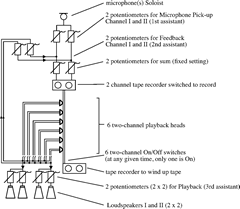
The instrumentalist’s sound is captured by a microphone (or microphones) and is fed through two potentiometers (controlled by the first assistant). These two signals continue on to a 2-channel tape recorder, where they are recorded onto Channels I and II. The tape then travels through the six playback heads and finally reaches a second tape recorder that functions solely to wind and store the tape. Only one of the playback heads is set to play at any one time during the piece. The playback heads are spaced at exact distances corresponding to the period durations of cycles (thus playback heads are not set to play in consecutive order). Once the tape reaches the playback head which is currently switched on, the recorded signals are fed through four potentiometers (controlled by the third assistant) and through four loudspeakers; at the same time, these signals are sent through a feedback circuit, in which they travel through another set of potentiometers (controlled by the second assistant) before being combined with the live sound captured by the microphone and added to the next period.
Summarizing, Stockhausen utilizes a variable-length tape delay (consisting of six different delay times) in combination with a feedback circuit. By instructing the assistants to open and close their potentiometers at precise times, Stockhausen controls the material entering the feedback system and the material being output. The diffusion of sound is monophonic; Stockhausen uses the two channels to increase the combinational possibilities of superimpositions. Stockhausen’s feedback system, unique for its time, allows for a surprisingly vast range of superimposed structures but has its limitations as well.
The original design for the tape apparatus made use of a table with guide rolls, eleven moveable tracks and six playback heads (Fig. 5) [Stockhausen 1969, 15]. In 1968, the first apparatus exclusively for Solo was built at the Studio voor Elektronische Musik of the Rijksuniversiteit in Utrecht, Holland and was made available for rent (Ibid., 20). This apparatus was a modified version of Stockhausen’s original design in which a tape loop passes straight through six horizontally moveable playback heads. It is important to note that this device in no way alters Stockhausen’s original feedback system; it is only a more efficient design of the apparatus from a technical standpoint. 5[5. When the tape loop re-enters the tape recorder, it first passes over an erase head, meaning the sound does not “loop” (the tape loops only in a physical sense). This design is more efficient and reliable because it requires one tape recorder instead of two, and passing the tape straight through the playback heads eliminates the need for guide rolls and moveable tracks.] A schematic diagramme and photographs of the modified apparatus can be found in the score notes.

The West Square Electronic Music Ensemble (founded in London in 1973 by Barry Anderson) had a feedback system built according to Stockhausen’s original design with the intent of showcasing Solo in a number of concert series and to commission new works for the system. Several performances of Solo were presented by the group over the course of 15 years: Christopher Taylor (flute, 1975), Barry Guy (double bass, 1976), Jane Manning (voice, 1977), Edwin Roxburgh (oboe, 1978/79), James Fulkerson (trombone, 1980/81) and Harry Sparnaay (bass clarinet, 1981) [Emmerson 1991, 183].
Unfortunately, the technology of the late sixties and early seventies lagged behind Stockhausen’s artistic vision for Solo. In addition to technical difficulties, the tape apparatus suffers from low fidelity, compromising the realization of superimposed electronic layers. Stockhausen addresses the issue of tape noise in the score and suggests the use of low pass filters to attenuate this effect. These issues affected the performability of Solo, to which Robin Maconie attests when he remarks in the 1990 edition of his overview of Stockhausen’s works that “Solo has had a chequered career” (Maconie 1990, 151).
However, the advent of portable, commercially available digital technology gave new life to Solo. In 1988, trombonist and researcher Benny Sluchin began considering a computer realization and by 1992 had completed, with the aid of Cort Lippe, a version of Solo that ran using Max on IRCAM’s Signal Processing Workstation and the NeXT computer (Sluchin 2000, 42). A modernized version followed in 1998 using an Apple Macintosh G3 running Max/MSP.
In our setup, the computer produces the delays, performs and coordinates the tasks of the four assistants (notated precisely by the composer), and gives the player an easy-to-use interface. The synchronization required in the piece is thus greatly simplified. The computer also handles the sound transformations. Because there is only one assistant necessary for the sound control in the performance space, and practically all of the tasks have now been pre-programmed, a more musical context between soloist and assistant can evolve (Sluchin 2000, 42).
More recent published computer versions of Solo include a realization in 2010 by Enrico Francioni using MacCsound and Csound, and a realization by Robert Esler in 2006 running Max/MSP; both versions automate all tasks, allowing the instrumentalist to perform without the aid of assistants.
Nowadays, a computer realization of Solo is quite simple to achieve using any of a number of commercially available or public domain software programs and a laptop computer. However, the automation of certain tasks is problematic because, as noted previously, the assistants at times carry out musical tasks affecting form and content (e.g., perforations and sound diffusion), and the output of sound, in the case of partial periods, is often content specific. Conceivably, an automated computer version of Solo could include programmable presets for all content-specific parameters, but consequently this would require an exact rendition of the score (only theoretically possible with a click track). The allocation of electronic superimpositions to output channels can easily be programmed, and while certain elements of diffusion could be automated, the diffusion of sound must be performed live in order to achieve the level of nuance which Stockhausen demands. Thus, a computer version of Solo must include at least one assistant (sound diffusion) and in practical terms (for authenticity as well), another two assistants to apply the perforations and, in certain cases, to interpret partial periods.
As a compromise to the live electronic version, Stockhausen allows the use of a 2-channel recording, prepared with strict adherence to the instructions in the Feedback Scheme and diffused live by an assistant, to which the instrumentalist plays in a concert performance. 6[6. It is important to note that Stockhausen carries out the role of the assistants himself, thus displacing their function from real time to non-real time; however, he does not negate their roles.] In fact, Stockhausen prepared a version of Solo in 1994 recorded on digital tape using a sequencer and a sampler in collaboration with flutist Dietmar Wiesner and Simon Stockhausen. This version replaced the tape apparatus for both Wiesner’s compact disc recording of Solo in 1995 and subsequent public performances (Stockhausen 1995, 26).
Analysis of Electronic Superimpositions and Techniques
This brings us to the analysis section, in which I will begin by examining and creating a nomenclature for electronic superimpositions, with the caveat that certain factors (which we will consider further on) may distort actual electronic output (e.g., perforations and acoustic rests). Electronic superimpositions form patterns and manifest techniques that evolve across complete and partial cycles. In an attempt to prove an overall structure of electronic form, I will present a topology of these patterns and techniques that demonstrates a systematic organization of elements. Then, we will compare these findings to an original sketch of electronic superimpositions in which Stockhausen methodically allocates patterns across Versions.
Superimposition Graphs
Although the Feedback Schemes provide precise instructions for the assistants, they do not present a clear visual image of electronic superimpositions, which we, however, require for analysis. Therefore, I have transferred the data from the Feedback Schemes of all Versions onto two sets of graphs in order to more clearly visualize superimpositions and facilitate analysis. The Electronic Superimposition Graphs (Appendix I) display electronic superimpositions while specifying the acoustic source (represented by the numbers above lines) and whether electronic periods result from the opening of microphone potentiometers (thus manifesting a tape delay) or from feedback. The Acoustic/Electronic Superimposition Graphs (Appendix II) combine acoustic and electronic periods without a visual division of channels, thereby providing the clearest representation of the actual structure of superimpositions within Solo. Reference to both sets of graphs will allow the reader to more clearly comprehend the analysis that follows.
Electronic Rests
We will begin by comparing the ratio between the presence of electronic playback (i.e. output from the feedback system from either Channel I or II) and the absence of electronic playback (i.e. lack of output from both Channels I and II). I will refer to the latter as electronic rests (most clearly visualized in Appendix I) and differentiate between complete rests (i.e. rests that last an entire period) and partial rests (i.e. rests that last for a segment of a period). Figure 6 enumerates the periods in which complete or partial rests (marked with an asterisk) occur and outlines four different types of partial rests (PR1–4).
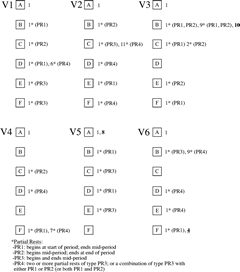
The first period of the first cycle of every Version (A1) is always a complete electronic rest — this is a condition of the feedback system, which requires at least one period of input before it is able to produce output (the time it takes the tape to travel from the record head to the playback head). Interestingly, this fact parallels the common practice of many traditional contrapuntal works, for example, the fugue, in which the subject first appears alone and the texture gradually builds as new voices appear.
Yet after A1, electronic playback predominates in all Versions. The few electronic rests that occur do so mainly during the first period of cycles, and the majority of cycles begin with some form of electronic rest. 7[7. One might presume that Stockhausen placed electronic rests at the start of cycles to avoid a sense of discontinuity that might arise from the change of playback heads (which could result in the abrupt cutting off of one electronic superimposition and the immediate entry of a different superimposition). While Stockhausen, for the most part, precedes or follows the change of playback heads with electronic rest, he does not always do so. Thus, in these cases we cannot conclude that electronic rests function solely as a means of avoiding this type of discontinuity.] In Version I and Version II (hereinafter V1, V2, etc.), rests occur in the first period of all cycles; in V3, V5 and V6, rests occur in the first period of all cycles except one; and in V4, rests occur in the first period of all cycles except two. However, rests occurring in the first period of cycles are always partial rests (except of course in A1). Across Versions, the most common type of partial rest is PR1, followed by PR2, PR4 and PR3; but the placement of the different types of partial rests does not appear to be systematic, except for the fact that they mainly correlate with the change of playback heads.
Electronic rests do occur in periods other than the first although the dispersion of such rests is extremely sparse. Every Version contains between one and three instances of rests occurring in a period other than the first, and except in cycle F4 of the sixth Version (V6F4), all these rests occur in the final period of cycles (or in the case of V3B9 and B10, the final periods). From a total of nine such rests, three are complete rests and six are partial rests.
Stockhausen’s placement of all electronic rests (except one) either at the end or beginning of cycles points to the fact that electronic rests play an important role in defining form by setting off cycles from one another. This fact is significant because the musical content of cycles (and for that matter periods) does not necessarily accomplish this task; therefore, electronic rests are in many cases important markers of form. Thus, the complete electronic rest in V6F4 seems to be an anomaly, and Stockhausen may have included it within this cycle to create a subdivision of form.
To summarize, Stockhausen creates a form in which electronic playback predominates. After A1, four different types of partial rests in different combinations often divide cycles from one another, but within cycles, electronic playback is constant (except the anomaly V6F4). Other than A1, complete rests are scarce (only three such occurrences across all Versions).
Electronic Canon Structure
Next, we will examine what I refer to as electronic canon structure. The use of the term “canon” here (borrowed from Stockhausen’s score notes) refers to the electronic playback of an “acoustic period” 8[8. I will use the term “acoustic” period to refer to the live sound of the instrumentalist and an “electronic” period to the output of the tape delay and feedback system.] in the immediately subsequent period. Stockhausen’s feedback system permits an acoustic period to be played back in the immediately subsequent period only if the microphone input for a channel is open in the current period and if the loudspeaker input for the same channel is open in the subsequent period (a manifestation of tape delay). Thus, Stockhausen’s feedback system allows for canons but does not necessitate them. Accordingly, an acoustic period may be played back in another period other than the immediately subsequent period (playback of an acoustic period may be delayed for two or more periods), or it may not reappear at all. Figure 7 outlines canon structure across Versions, i.e. the presence or absence of electronic canons in all periods of all cycles.
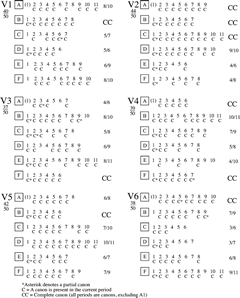
Canon structure predominates in all Versions (the ratio of canons to the total number of periods, excluding A1, in Versions ranges from 37:50 to 44:50) and every cycle of every Version contains at least three canons (the ratio in cycles ranges from 3:7 to 11:11). However, the average ratio of canons to periods in cycles is fairly high; nearly all cycles contain a majority of canons, only a few do not (V4E, V6C and V6D). As well, every Version contains at least one complete canon structure (a cycle in which all periods are canons); V2 contains three such cycles and V4 contains two such cycles.
The majority of canons are complete repetitions of an acoustic period, but a much smaller number of canons are partial repetitions. In addition, most partial canons occur in the first period of cycles, and the majority of first period canons are partial canons (18 of 23). Of course, the use of partial canons in first periods is linked to partial electronic rests, and this explains their use here. Only seven partial canons occur in a period other than the first period (V1C6, V3A3, V3B9, V3C2, V4F7, V6A5 and V6B9).
Thus, Stockhausen clearly favours the use of canon structure in all Versions, which leads one to ask, why did he rely so heavily on canons when he had at his disposal a feedback system surpassing the capability of a simple tape delay? The answer may be that he was attempting to maintain a sense of continuity and structure. An electronic canon functions here much the same way as a canon does in traditional contrapuntal music: binding new musical phrases with the old, while maintaining unity. Although the use of canons maintains unity when the number of periods is relatively low (2–4), in denser textures (4–11) canons would no longer have the same unifying effect. In such textures their unifying role would be nullified and instead an entirely different effect would be created. As well, in order to build accumulation structures, canons must be formed. 9[9. I have limited my analysis of canon structure to occurrences of single period canons, but canons often repeat for more than one period.] Thus, we will see that canons are mainly used as part of larger structures. This leads us to the next section of the analysis, where we will examine more thoroughly the use and placement of electronic material.
Complete Cycle Superimposition Patterns
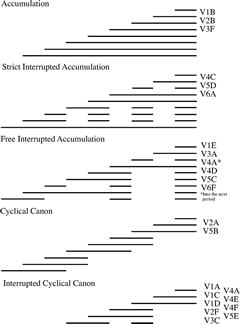
Referring to the Acoustic/Electronic Superimposition Graphs (Appendix II), it becomes immediately evident, visually, that certain logical and often symmetrical superimposition patterns exist within cycles. In order to describe and categorize these patterns, I have devised a terminology relating to how such structures might be perceived aurally. First, we will examine patterns that occur over the duration of an entire cycle (i.e. complete cycle superimposition patterns) and I will attempt to describe their hypothetical musical effect. Figure 8 illustrates the visual characteristics of each acoustic / electronic superimposition pattern. (For now, we will ignore the feedback from previous cycles that carries into the current cycle; we will, however, consider this feedback in the section on partial cycle patterns.) In addition to these patterns, I will discuss what I refer to as a complete cycle drone.
Accumulation Patterns
Accumulation utilizes the full capabilities of Stockhausen’s feedback system: microphone levels are constantly open, feedback levels are constantly open and loudspeakers levels are constantly up (though not necessarily in both channels). In total, three instances of complete cycle accumulation occur across Versions (V1B, V2B, and V3F). The effect of such a structure is musically unique: in the case of V1B, it would be analogous to eight layers of ostinati. But full accumulation could prove overwhelming to a listener. The use of canons in the first few periods of a cycle may aid in creating a coherent, unified musical texture, but most likely from the fifth period on, any such effect would be nullified due to the fact that the human brain is not capable of processing so many musical layers. At a certain point, individual superimpositions might no longer be discernible; instead, the listener would only perceive a change in musical content as superimpositions would blend into a chaotic whole. This effect could be advantageous to a composer as a unique means of development; however, Stockhausen mostly avoids these potential problems by employing accumulation in only a few instances and in cycles with a relatively lower number of periods (8, 7 and 6 respectively for V1B, V2B and V3F). Thus, Stockhausen avoids the use of this structure in cycles with more periods, possibly to avoid the inherent musical pitfalls.
Stockhausen makes use of two variations of accumulation (Fig. 8). The first is strict interrupted accumulation, which alternates full accumulation (i.e. accumulation of all previous periods) with sub-accumulation (i.e. accumulation of a subset of periods) on successive periods beginning in the fourth or fifth period. Additionally, sub-accumulation follows a consistent logical pattern, and the final period always reaches full accumulation. For example, in V5D, the first interruption occurs in the fourth period with the omission of D2, and subsequent interruptions occur in even-numbered periods with the omission of even-numbered electronic periods. In V6A, sub-accumulation follows an equally strict pattern, but less so in V4C. Three such patterns occur across Versions (V4C, V5D and V6A).
The second variation, free interrupted accumulation, is a less strict version of its counterpart in which interruptions do not necessarily alternate on successive periods and in which sub-accumulation does not necessarily follow a logical pattern. In total, six such patterns occur across Versions (V1E, V2E, V3A, V4D, V5C and V6F). Despite the fact V4A has not been included in this classification, it does present an interesting case, as it reaches full accumulation in the first period of the following cycle.
The two interrupted accumulation patterns offer the listener a respite from the possibly static structure of accumulation by including variation, especially in the case of free interrupted accumulation. Most likely as a result, Stockhausen includes more occurrences of the latter than the other two types of accumulation.
Cyclical Canons
The next pattern, the cyclical canon, I define as a continuous series of canons that cycle within a relatively sparse texture (maximum three layers). For example, in V2A, all periods are canons, and all periods, except P6, repeat twice, producing a texture that builds to three layers in the third period, diminishes to two layers in the eighth period, and returns to three layers in the final period. The only other example of a cyclical canon, V5B, strictly maintains a two-voice texture. The definition limits the number of layers to a maximum of three because a denser structure would produce an effect more in line with an accumulation pattern or a chordal block (which we will examine further on). Although cyclical canons must be complete canon structures, complete canon structures do not by definition always result in cyclical canons. Most other complete canon structures result in some type of accumulation pattern, with the exception of V4F, which forms the next pattern we will consider.
The interrupted cyclical canon is a less strict version of the cyclical canon in which acoustic periods do not necessarily have to form canons, yet most periods still do (V4A and V4F are the only examples exhibiting complete canon structures). As well, repeated periods are sometimes interrupted for a single period and return in the next period. As with cyclical canons, the texture consists of between two to three layers, yet occasionally, and only for a single period, the texture may increase to four layers. For example, in V1A interruptions begin in the fifth period: electronic period one (hereinafter P1) returns after a rest in the fourth period, and electronic P3 does not repeat for a second time as the other superimpositions do. In the sixth period, electronic P1 returns again, and acoustic P5 does not form a canon. Periods 7–9 contain similar interruptions, and P10 consists of four layers as electronic P7 persists for an extra period after being interrupted in P8. In total, Stockhausen makes use of nine interrupted cyclical canons (V1A, V1C, V1D, V2F, V3C, V4A, V4E, V4F, V5E).
Cyclical canons and variations thereof provide the listener with an anchor to guide their listening, somewhat analogous to the experience of traditional contrapuntal music. As well as providing an anchor, interrupted cyclical canons engage the ear by varying the texture: the number of layers fluctuates and the composition of layers changes in much less a predictable pattern than in cyclical canons.
Drones
Finally, we will consider the complete cycle drone, which I define as a period (or periods) that repeats (loops) for an entire cycle. Stockhausen employs five complete cycle drones across Versions (V2E1, V3A1, V4D2, V6A1 and A2, and V6C2), with V6A being the only example of a double drone. The first or second period must form the drone, so that the drone is able to establish itself as an entity within a cycle. As well, in order for the listener to perceive a drone, it must mainly occur within a relatively sparse texture (usually two to three layers but also less frequently four). Drones may be occasionally “hidden” within chordal blocks of five layers or more; however, exposed drones (i.e. drones that occur in a sparse texture) must outnumber hidden drones, and hidden drones can at the most only alternate between exposed drones, meaning hidden drones cannot occur consecutively. Finally, drones occurring within complete cycle accumulation will not be considered (accumulation structures naturally consist of a series of drones, though the drones function much differently here, being subsumed within a larger process). Drones may, however, exist within complete cycle interrupted accumulation patterns. For example, in V2E the first period functions as a drone, but in the fifth, seventh and ninth periods it is hidden within chordal blocks (V2E extends into the next cycle for three periods). In addition, all complete cycle drones extend into the next cycle for either a full period, partial period or partial periods, for example: V3A1 and V4D2 extend into the following cycle by a full period; V2E1, V6A1 and V6A2 extend into the next cycle as a partial period; and V6C2 extends as partial periods.
Complete cycle drones can, but do not necessarily have to, occur within any of the complete cycle patterns. For example, the complete cycle drone in V2E does not occur within accumulation or a cyclical canon, but those in V3A, V4C, V4D and V6A all occur within interrupted accumulation patterns. As well, V6A is the only case of a double drone: P1 and P2 form a complete cycle drone.
The musical effect of drones depends largely on their content: repetition of a period containing a single tone results in a drone effect, but various types of melodic or rhythmic ostinati could also be formed.
Partial Cycle Patterns and Period Elements
All the aforementioned superimposition techniques occur within partial cycles as well. In what follows, we will examine these techniques along with several new devices that occur only within partial cycles: interrupted drones, deaccumulation, delayed canons and chordal blocks.
Partial Cycle Accumulation and Cyclical Canons
Partial cycle interrupted accumulation and cyclical canons of all types must be at least three periods in length in order to be recognizable as patterns (accumulation, on the other hand, must only be two periods in length), but otherwise these superimposition patterns follow the same guidelines as their complete cycle counterparts. However, we will ignore any type of partial cycle accumulation that occurs within any type of complete cycle accumulation or cyclical canon, since accumulation is inherently subsumed within these processes. The only exception will be accumulation that extends into the following cycle, as it is important to mark this.
Partial cycle accumulation occurs frequently (14 instances) and, except for V5, in all cycles. Partial cycle strict interrupted accumulation occurs only twice (V5C1–C6 and V6E1–E5) and partial cycle free interrupted accumulation occurs in three instances (V1F1–F4, V2D1–D7, and V5F1–F6). Accumulation only extends into the following cycle in one case (V2D10–E1). As accumulation is the natural product of Stockhausen’s feedback system, it is not surprising that it continues to function as an important superimposition technique in partial cycles as well.
Partial Cycle Drones and Interrupted Drones
Partial cycle drones differ from their complete cycle counterpart in that they must span at least four periods, the drone must be exposed for at least two of these periods, and they do not occur within partial accumulation patterns of four periods or more. An example of a partial cycle drone occurs in V1E: acoustic P2 forms the drone and continues until the sixth period. Five partial cycle drones occur across three Versions (V1C1, V1E2, V1E6, V3C2 and V5C3), and in V1E two drones overlap. Unlike complete cycle drones, only one partial cycle drone extends into the next cycle, but here it no longer continues to function as a drone; its use is instead more structural, as it forms part of a ten-layer chordal block.
Interrupted partial cycle drones follow the same guidelines as partial cycle drones except that the drone may be interrupted by a single or partial period of rest one or more times (V1A1, V1D4, V1F1, V1F3, V2D1, V2E6, V3E1, V4B2, V5F2, V5F4 V6C1, V6D1, V6D2, V6E1 and V6E2). Interrupted partial cycle drones occur more frequently than partial cycle drones (15 occurrences of the former compared to 5 of the latter), and they occur in all Versions. I have excluded V4B6 as an interrupted partial cycle drone because, even though it does meet the above criteria, the drone never has a chance to establish itself as aurally recognizable because it is immediately buried within a four-layer texture in B7–8, and upon its return in B10 it is again buried in a chordal block of five layers (V2D2, V5C2 and V5F1 present similar circumstances). Additionally, in V1F, V5F, V6D and V6E, two interrupted partial cycle drones overlap. Finally, the majority of interrupted partial cycle drones extend into the next cycle: V6D1 and V6D2 as full periods, and V1D4, V2D1, V2E6, V3E1, V6C1, V6E1 and V6E2 as partial periods (V2E6 extends three periods into the next cycle). However, most of this extension is structural, as the overlap moves onto chordal blocks of five layers or more (except V1D4 at two layers). All interrupted partial cycle drones that extend into the next cycle, with the exception of V1D4 and V2E6 (and with the addition of V5F2), occur over the length of an entire cycle, although the process is interrupted. Stockhausen consistently uses the different drone types across all Versions and they play an important unifying structural role within cycles.
Chordal Blocks
Chordal blocks span a full or partial period and involve the sudden addition of two or more electronic layers to a period. Accordingly, chordal blocks contain a minimum of three layers including the acoustic period, but more often they contain a greater number of layers (up to 12, e.g., V3F1). As well as the sudden addition of layers, a sudden subtraction of layers most often, though not necessarily, follows chordal blocks. For example, following the partial period chordal block in V1B1, there is a reduction from six layers to one (6-1). However, chordal blocks may also be followed by a decrease of just a single layer, an increase of a single layer (at most) or a voice exchange, which involves the simultaneous addition of a new acoustic period with the subtraction of an electronic period. Stockhausen makes frequent use of chordal blocks (more than any other superimposition technique) and they often appear more than once within a single cycle. For example, V6A contains four chordal blocks and every cycle except for V1A, V1E, V2B, V4E and V5A contains at least one chordal block.
Chordal blocks fall into two categories, structural chordal blocks and cadential chordal blocks. The first category includes chordal blocks that are subsumed within the processes of interrupted accumulation patterns and interrupted cyclical canons (although there are only three examples of the latter: V1C4, V4A4 and V5E5). Across Versions, Stockhausen employs 23 such chordal blocks (e.g., V5D5, D7, D9 and D11). These chordal blocks create variety within the texture but at the same time tend to blend in with the textural development taking place and do not, in themselves, play an important formal role; however, the second category of chordal blocks do, as they serve mainly to mark divisions between cycles. This fact is important because, as mentioned previously, an inherent formal musical division between cycles does not necessarily exist.
The vast majority of cadential chordal blocks occur in either the first period or the final period of cycles and act as markers of form by emphasizing the formal division between cycles, mainly by virtue of a sudden change in texture. With cadential chordal blocks, Stockhausen achieves a division between cycles through the use of several different methods. For example, in V5B1 there is an abrupt change to six layers from one layer in A8 and then an abrupt return back to one layer in B1 (partial period cadential chordal block). Abrupt changes from a relatively large number of layers to an acoustic layer are a characteristic of cadential chordal blocks and occur frequently. Stockhausen at times precedes a cadential chordal block by a sudden reduction in layers, usually at the end of some type of accumulation process; for example, the cadential chordal block in V1C1 is preceded by a reduction from eight layers to one, the last period of V1B being the apex of an accumulation pattern. This example represents one method of framing a structural division between cycles. In V5E1 another method is used: the chordal block is preceded by another chordal block in V5D. In fact, Stockhausen will sometimes employ a series of partial period chordal blocks, such as in V2C11–D1 (where he uses seven in a row) and V6D1. The appearance of chordal blocks in partial periods is exclusive to initial and final periods (with one exception: V1F2–F3), so we can add that standalone partial periods (i.e. periods separated from the previous or following whole period with a rest) serve to mark formal divisions as well. (Connected partial periods are used but are imperceptible.)
Stockhausen uses cadential chordal blocks in the first period of every cycle except for V1E, V2E, V4E and V5D. However, V2E, V4E and V5D are all preceded by cadential chordal blocks in the final periods of their respective cycles. As well, in these cases the final period chordal blocks are extended into the first period of their respective cycles for a partial period, followed by a sudden, large layer reduction (6-1, 8-2 and 10-1, respectively). Thus, even though these cycles do not contain first period cadential chordal blocks, they are still separated by chordal blocks (V4E and V5D by cadential chordal blocks, and V2E by a structural chordal block, although here it has a dual function and could also be considered a cadential chordal block). Although V1E is the only exception, it mimics the partial standalone period technique, and even though this effect is on its own not as strong as cadential chordal blocks, it still provides a level of formal division.
But not all cadential chordal blocks occur in the first or last period of cycles, and as such create interesting perceptions of form. One such case occurs in V3B9, which ends with a partial period cadential chordal block and is followed by a reduction from three layers to one. Although B10 is the final period of V3B, the listener could easily perceive this as the beginning of a new cycle. In V1C1, there is another cadential chordal block (1-10-1) with a much stronger character, which may signal the actual start of new material. Thus, the cadential chordal block in V1B10 serves as a “deceptive” cadence (weaker in layer reduction), followed by a stronger “authentic” cadence in C1. Similar deceptive cadences occur in V1F7 and V4B10. The only other occurrence of a mid-period cadential chordal block is V3E7, and this occurrence is something of an exceptional case as it manifests a relatively large layer addition and reduction (2-7-2). As well, it occurs towards the middle of the cycle, contrary to the other examples that appear near the end. This cadential chordal block could function to create a division within the cycle, but V3E maintains a sense of unity due to the E5–F1 drone which binds the cycle together until an even stronger cadential chordal block in F1 (5-12-1), the sole instance of the use of 12 layers in any Version.
In summary, Stockhausen’s use of chordal blocks, and especially cadential chordal blocks, plays an important role in defining form, and chordal blocks are probably the most readily recognizable superimposition technique, as well as the most frequently used.
Deaccumulation
Deaccumulation involves a reduction of layers over a partial period (in only two instances), a single period or a number of periods; however, I will not classify a reduction of layers following a chordal block as deaccumulation — as mentioned previously, a chordal block, in itself, often entails both the sudden addition and subsequent subtraction of layers. As well, deaccumulation mainly involves the reduction of a single layer per period and at most two layers per period. From a total of 26 occurrences of deaccumulation, only four involve the reduction of two layers (V2A7–A8 has 6-5-4-2 layers, V3B6–B8 has 6-4-2, V4B4–B5 has 4-2, and V4B8–B9 has 4-2 layers). Due to the nature of Stockhausen’s feedback system, a reduction of layers can only occur after an accumulation of layers; therefore, deaccumulation occurs mid-cycle or later. Stockhausen reaches but never surpasses four consecutive periods of deaccumulation; however, the average span is two periods. Deaccumulation occurs only five times over a span greater than two periods. An example of deaccumulation occurs in V1F4–F6, which decreases by one layer in each period over a span of three periods (4-3-2).
To a certain extent, deaccumulation serves to balance the aural effect of accumulation, but Stockhausen’s feedback system is limited in that the maximum possible span of deaccumulation is five periods (although Stockhausen does not exploit this possibility). As well, Stockhausen achieves accumulation through a natural process (which simply involves leaving the microphone, feedback and output levels open). The manifestation of deaccumulation, on the other hand, is much less straightforward and involves specific manipulation of the feedback system, which is the main reason accumulation processes dominate throughout Solo.
This is especially true regarding the three instances of deaccumulation that span four periods (V2C6–C9, V5A5–A8, and V6B5–B8). (The clearest manner in which to see this process at work is to refer to the Electronic Superimposition Graphs in Appendix I.) For example, in order to achieve a layer reduction of 5-4-3-2 in V6B5–B8, the feedback system accumulates two different electronic periods in each of Channels I and II (2/4 and 1/3, respectively), which combine with the acoustic material in P5 and add up to five layers. In the next period, the third assistant closes the output for Channel I, and another layer is added to Channel II (1/3/5), which combines with the new acoustic period to create four layers. In the same period, the second assistant closes the feedback input for Channel II, clearing all material so that feedback output will be empty for the next two periods. The third assistant then closes the output for Channel II in P7 and reopens the output for Channel I (2/4); however, no new layers have been added so the texture now totals three layers with the addition of the new acoustic period. In P8, Channel I is closed and Channel II is reopened; feedback output on Channel II is now empty but a new period has been added through the microphone input (during P7), resulting in a total of two layers including the acoustic period. (Stockhausen could have continued deaccumulation into the next period by closing both output channels, leaving only the acoustic period; using this method, five periods of deaccumulation would have been possible.)
Therefore, deaccumulation spanning four periods relies on manipulation of both output channels (among other factors) to effectuate a gradual reduction of layers. The same holds true for deaccumulation spanning two or three periods. In fact, Stockhausen utilizes five methods of channel manipulation: an alternation between channels (spanning two or three periods); moving from a single channel to closing both channels (spanning two periods, only occurrence being V6F3–F4); moving from two channels to a single channel (spanning two periods); moving from two channels to an alternation of channels (spanning three or four periods); or an alternation of channels followed by closing both channels (spanning four channels, only occurrence being V5A5–A8). Thus, diffusion in Solo is often more a matter of achieving certain superimposition techniques rather than diffusion for its own sake (or possibly vice versa).
Although Stockhausen’s superimposition techniques are quite simple to achieve with modern computers and software, the degree to which he was capable of pushing the limitations of his feedback system are quite astounding. Two interesting examples are V5A and V6B, which both display a mirror image accumulation and deaccumulation process, expressed in number of layers per period: 1-2-3-4-4-3-2-1 and 1-2-3-4-5-4-3-2-1 respectively (disregarding partial period chordal blocks in the latter).
Delayed Canons
The majority of periods form canons, but those that don’t fall into several categories: periods that never repeat (e.g., V1D5); periods that eventually repeat but within some type of accumulation pattern (e.g., V1E3) so that their reintroduction is not aurally perceivable and their use is mostly structural (in the sense that they are used to build a dense layer structure); and finally, the reintroduction of a period with a delay of a single period into a texture where this period is recognizable. I will refer to the latter instance as delayed canons, of which there are five examples (V1A5, V1A7, V4E2, V4E5 and V5E8) and only within two different Versions and two different cycles. Although delayed canons appear infrequently, their use is interesting: they function to create a similar unifying effect to canons and contribute to an overall sense of “memory” form.
Non-recurring Techniques
In addition to the recurring complete cycle and partial cycle patterns and techniques I have outlined, Stockhausen makes use of a variety of superimposition patterns which do not recur but still exhibit logic and/or symmetry in their design. For example, in V6D Stockhausen employs two interrupted drones (D1 and D2) that alternate beginning in the third period and continue until the end of the cycle. At the same time, P3–P7 do not form canons (the only incidence of four consecutive periods not forming canons), but the use of the alternating double drone maintains a sense of unity and structure throughout the cycle.
As well, much more complex and irregular patterns exist; an examination of the Superimposition Graphs will reveal other non-recurring patterns; however, these patterns are beyond the scope of the present analysis.
Static Layer Density
Next, we will turn to a discussion of layer density: the number of acoustic and electronic layers present in each period (indicated at the bottom of each period in the Acoustic/Electronic Superimposition Graphs [Appendix II]). In general, layer density is dynamic, for the most part continually decreasing or increasing mainly by a factor of one. Again, the exception is chordal blocks, which involve abrupt changes in layer density occurring mainly at the beginning and end of cycles or during interrupted accumulation. Another exception is what I will refer to as static layer density, which occurs when the number of layers remains unchanged from one period to the next.
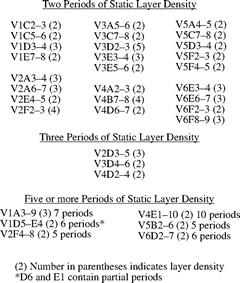
Figure 9 demonstrates that instances of two periods of static density are fairly common and occur within all Versions, but three periods of static density are much less common, occurring only three times within three different Versions. In these cases, the number of layers per period is usually two or three, only occasionally reaching four, and in one case five. But these instances of static density are generally too short to be perceived as a deviation from the norm and thus are not of great significance.
Much more pertinent are the six instances of static density exceeding four periods, which Stockhausen makes use of in all Versions except V3. For example, in V1A3–A9 layer density remains static at three for a total of seven periods. In all the other examples of static layer density exceeding four periods, there are a total of two layers and the length of each ranges from 5–10 periods. I have listed V1D5–E4 as an example of static layer density, although in D6–E1 density does change briefly due to the use of an interrupted drone. All examples of static density exceeding four periods occur as part of interrupted cyclical canons except for V6D2–D7. As well, V1D5–E4 occurs across two cycles (an interrupted cyclical canon, and free interrupted accumulation). Although dynamic layer density predominates, static layer density, and most especially instances exceeding four periods, acts as an important method of textural variation.
Summary of Superimposition Patterns and Techniques
I have presented and endeavoured to categorize a list of superimposition patterns and techniques that recur across cycles, and as we have seen, certain patterns do recur and certain techniques are common among Versions. Thus, the use of electronic superimposition structures across cycles employs recognizable techniques and patterns. In addition, superimposition patterns predominately exist within a single cycle, only occasionally extending into the following cycle, but in no instances do patterns exist over the span of two or more cycles. As a result, superimposition patterns mark the boundaries of cycles, along with cadential chordal blocks and electronic rests, and establish cycles as independent formal entities.
Topology of Superimposition Patterns
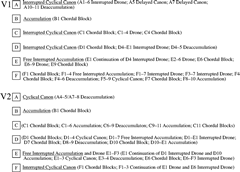
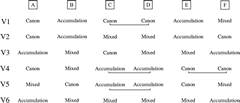
Having categorized the various superimposition techniques at Stockhausen’s disposal, we will now turn to an analysis of their use. Figure 10 presents a topology of superimposition techniques across Versions. In Figure 11, I have condensed the various subcategories of superimposition techniques down to their basic elemental patterns (canon and accumulation) and have labelled cycles not displaying a single uniform pattern as mixed.
Stockhausen distributes the three condensed patterns types fairly evenly across cycles. As well, all Versions, except V6 (which omits a canon), contain at least one cycle of all three condensed pattern types. Furthermore, from V1 to V5 Stockhausen mainly intersperses pattern types, for the most part avoiding consecutive fixed patterns, but with four exceptions: in V1 between cycles C and D (interrupted cyclical canons), in V4 between C and D as well (strict interrupted accumulation and free interrupted accumulation, respectively), again in V4 between E and F (interrupted cyclical canons), and in V5 between C and D (free interrupted accumulation and strict interrupted accumulation). The alternation of fixed pattern types creates formal variety. (Consecutive mixed patterns, of course, do not oppose this principle.) Only V6 does not follow an alternating pattern as it begins and ends with accumulation and the inner cycles are all mixed; however, it still follows the same principle of formal variety.
A Systematic Allocation of Superimpositions: Layer Density Patterns

Although our analysis of complete cycle superimposition patterns and techniques does not point to an entirely systematic organization, Stockhausen did conceive a precise system to determine and allocate superimpositions. In a sketch of electronic form (Stockhausen 1971, 88–89), Stockhausen organizes superimpositions into six groups, apparently on the basis of layer density patterns, and disperses these patterns across the six Versions of Solo using a system similar to the one for the allocation of period durations. 10[10. For a detailed discussion and explanation of the system used for the allocation of period durations, see the full paper.]
In Figure 12, I have transcribed the schematic of layer density patterns from Stockhausen’s sketch. Stockhausen omits feedback from previous cycles (as we did in the analysis of superimposition patterns), but he also omits partial periods. In addition, Stockhausen’s sketch is not an exact representation of the feedback schemes (deviations are marked with dotted lines).
I will begin with an analysis of the layer density patterns from Stockhausen’s original sketch (ignoring deviations for now). Stockhausen groups the layer density patterns into six categories (represented by the numbers in boxes), each displaying similar characteristics. Group 5 consists of accumulation structures: the first three patterns display full accumulation and the remaining three display interrupted accumulation; all patterns end with full accumulation. Group 6 patterns also display accumulation structures ending with full accumulation, but the density of overall accumulation is lower than in Group 5 and is not systematic. Group 4 patterns reach accumulation of approximately half the total layers; the first two patterns involve two nearly equal points of accumulation and the remaining patterns involve three equal (or nearly equal) points of accumulation. Group 3 patterns accumulate to a point of static density of two layers in the case of the first five patterns and of three layers in the final case. Group 2 patterns all involve a symmetrical accumulation and deaccumulation structure. Finally, Group 1 patterns involve an accumulation to a peak point in the middle of the cycle followed by deaccumulation and then accumulation to another lesser point.
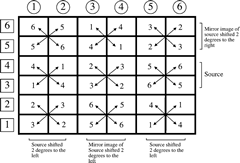
The dispersion of layer density patterns across Versions follows a process that incorporates symmetry, logic and a number of arbitrary decisions on the part of Stockhausen; I have illustrated this process in Figure 13. Thus, Stockhausen did have in mind a systematic method of deriving and allocating superimpositions; however, deviations and the later addition of partial periods somewhat obscure the original conception of superimpositions.
Next, we will examine the extent to which deviations and the existence of partial periods (cf. Appendix II) alter the original layer density schematic presented in Stockhausen’s sketch. In most cases, deviations in layer density result in minor variations and do not alter the categorization of patterns. The only exception might be V3D; with the addition of three layers in the final period, V3D becomes an anomaly, as it no longer fits into the categorization of Group 5 or any other group. The addition of partial periods does not significantly alter layer density patterns, with the exception of most of the Group 2 patterns. In fact, only V5A retains its original accumulation/deaccumulation structure; in all other cases the addition of partial periods at, or near, the end of cycles completely obscures the structure of these patterns. This is especially the case with V3B and V2C because they are altered by both deviations and partial periods. Therefore, Group 2 patterns exist only at a pre-compositional level, but the remaining patterns retain their defining characteristics.
A comparison of Stockhausen’s schematic of layer density patterns with our analysis of superimposition patterns and techniques reveals a number of correlations. Layer density patterns in Group 5 and 6 correlate precisely with the accumulation patterns. Group 3 patterns correlate to occurrences of static density, and Group 2 patterns, for the most part, correlate to occurrences of deaccumulation. However, canon structures, which are spread across Groups 1 to 4, do not correlate with any specific group.
Stockhausen’s schematic of layer density patterns explains the usage and allocation of different superimposition patterns across Versions, but it does not provide a meaningful understanding of the functionality of all the patterns and techniques in use. And while our analysis of superimposition patterns and techniques elucidates this important functional aspect, it does not offer a systematic method of allocation. Thus, Stockhausen’s sketch of layer density patterns and our analysis complement each other, creating a vital bridge towards the comprehension of electronic form in Solo.
Factors Influencing the Superimposition Structure Paradigm
Having completed our analysis of superimposition patterns and techniques, it is important to recall that the material in the superimposition graphs is not an exact representation of actual electronic output. Perforations, acoustic pauses, and acoustic entry types alter, to a varying degree, the output of electronic material. In what follows, we will examine the extent to which these factors influence the superimposition structure paradigm.
Perforations
Stockhausen defines “perforations” as short interruptions that serve to add variation to the playback of periods. Assistant I (microphone) and Assistant II (feedback) attain these interruptions by briefly closing and reopening their respective potentiometers; this process is carried out ad lib., and Stockhausen provides no specific instructions regarding the exact duration of perforations other than remarking that single tones may be omitted from melodic sequences and held tones may be “punctured”. Perforations are permanent and cumulative: once a perforation has been applied to a period it will remain in all subsequent electronic repetitions, and perforations implemented by Assistant II affect all periods currently being played back via the feedback circuit. Figure 14 illustrates this process for V5A. (I have distributed the perforations randomly in this hypothetical example.)
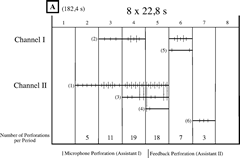
Every cycle of every Version contains perforations although the number of perforations varies greatly between cycles. The number of perforations per instruction is between 0–13, but the vast majority fall into the range of between 0–3, occasionally 4, and rarely 6–13. In general, cycles with shorter period durations have less perforations per instruction (ergo per cycle as well); for example, in cycles with period durations of six seconds, the number of perforations per instruction is in the vast majority between zero and two and occasionally, but never more than three. Clearly, performability dictates the number of perforations per period in the latter case since more than three perforations during a six-second period would not be feasible. Although cycles with longer period durations do sometimes have more perforations per instruction, this is not necessarily the case. For example, V5B (6 x 45.6s) contains a relatively high number of perforations per instruction in three out of eight cases (13/8/5/3/0/2/0/0) whereas V3F (6 x 45.6s) exhibits the opposite tendency (2/2/0/1/0/1/0/0/3/0/0/1/0/3/0/0/3/2).
Furthermore, the effect of perforations is often cumulative; thus, in certain cases, periods towards the end of cycles, and especially cycles with a greater number of periods, will be altered the most, meaning that perforations could have a reverse effect on accumulation. For example, in V6F (11-period free interrupted accumulation) the parallel accumulation of a relatively large number of perforations may significantly attenuate the actual density of P10–11 (full accumulation).
Since the implications of perforations are visible in the Feedback Schemes, I will not pursue a more detailed analysis here. Suffice it to say that perforations do, to a varying extent, alter the paradigm presented in the superimposition graphs, but not drastically so.
Acoustic Pauses and Entry Types
In the preparation of the performance score, Stockhausen prescribes the use of pauses between parts and elements. Pauses fall into three categories based on duration: relatively long, relatively medium, and relatively short. Stockhausen further stipulates that in longer periods pauses may last up to 50 percent of the period’s duration, and in shorter periods up to 90 percent: an example of a long rest in a period with a duration of 34.4s would be a pause of between 15–20 seconds. In every Version, one cycle has no pauses (the cycle in which only systems are interpreted), but all other cycles contain one of the three types of pauses, or a combination of two thereof. In such cases, the use of pauses is mandatory between all entries (with one or two possible exceptions permitted per Version). Thus, rests make up a significant portion of the acoustic material of every Version.
Although prescribed durations of acoustic pauses are the main factor in determining the placement of rests, acoustic entry types (Polyphon, Akkorde and Blöcke) also play an important role. For example, in cycles in which the performer has a choice between using two different lengths of pauses, the acoustic entry type will govern to a large extent the placement and duration of pauses, as the performer attempts to adhere to Stockhausen’s intended textures. Thus, acoustic entry types play an important role in shaping the electronic texture on a micro-level, as opposed to the electronic superimposition patterns that shape form on a macro-level.
Summary of Factors Influencing the Superimposition Structure Paradigm
Due to the fact that such a great deal of electronic material will consist of recorded rests, consideration of acoustic pauses is paramount to a clearer conceptualization of electronic form in Solo. Thus, we have ascertained that the superimposition graphs can only serve as initial fixed frameworks of form, from which perforations, acoustic entry types and, most importantly, acoustic pauses (all non-fixed elements of form) modify these frameworks through processes of omission.
Conclusion
Stockhausen systematically allocates a set of logically and musically conceived superimposition patterns across Versions, and these patterns, along with a range of superimposition techniques, generate the subdivisions of form within Solo. Complete cycle superimpositions patterns, which include accumulation, cyclical canons and drones, formally define cycles; cadential chordal blocks and electronic rests punctuate these formal boundaries, while both structural and cadential chordal blocks carry out the function of densely recapitulating material; and superimposition techniques, including partial cycle superimposition patterns, deaccumulation, static layer density, delayed canons and various non-recurring techniques, act to unify cycles and delineate further subdivisions of form. Finally, page structure, functioning at a hierarchical level superior to that of cycles, binds these processes into a unified whole.
Stockhausen strives for a new conception of form, a “memory” form involving an interaction of acoustic and electronic feedback. Solo could be considered thematically non-developmental, but I contend that Stockhausen achieves a different type of development: a development through structure, texture and diffusion that amalgamates these traditional elements of form, thus creating a continuous, temporally displaced exposition/development/recapitulation paradigm.
Stockhausen strove for, and achieved, “something new” in the composition of Solo; although his original intentions underwent a transformation in which the idea of a “structure formation” takes on a new meaning, the kernel of Stockhausen’s idea persists in the manifestation of electronic superimpositions. Today, Solo occupies a seminal position in the repertoire of live electronic music involving the recording, playback and processing of sound from an instrumentalist(s) during concert performance.
Appendix I — Electronic Superimpositions Graphs
The following Electronic Superimposition Graphs display electronic superimpositions while specifying the acoustic source (represented by the numbers above lines) and whether electronic periods result from the opening of microphone potentiometers (thus manifesting a tape delay) or from feedback in a performance of Solo.
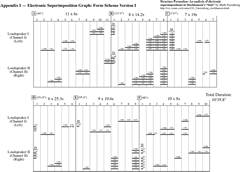
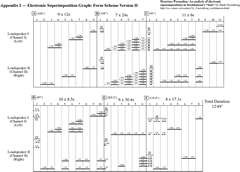
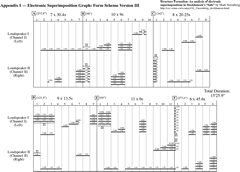

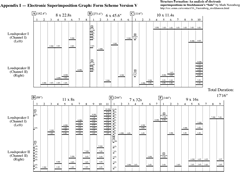
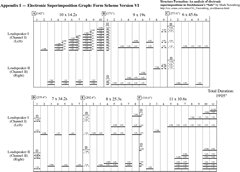
Appendix II — Acoustic/Electronic Superimpositions Graphs
The following Acoustic/Electronic Superimposition Graphs combine acoustic and electronic periods without a visual division of channels, thereby providing the clearest representation of the actual structure of superimpositions within Solo.
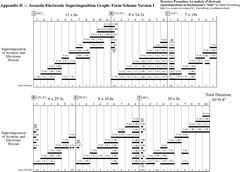

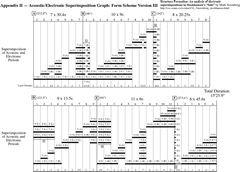

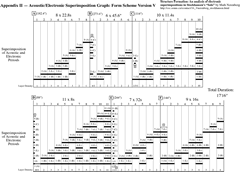
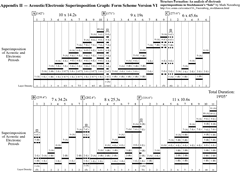
Acknowledgements
I would like to extend thanks to Scott Wilson for his advice while writing the full paper.
Bibliography
Chadabe, Joel. Electric Sound: The Past and Promise of Electronic Music. Upper Saddle River NJ: Prentice Hall, 1997.
Emmerson, Simon. “Live Electronic Music in Britain: Three case studies.” Contemporary Music Review 6/1 (1991) “Live Electronics,” pp. 179–195.
Esler, Robert. “Digital Autonomy in Electroacoustic Music Performance: Re-Forging Stockhausen.” ICMC 2006. Proceedings of the International Computer Music Conference (New Orleans, USA: 2006). Available online at http://www.robertesler.com/Esler_ICMC_2006.pdf
Francioni, Enrico. “SOLO_MV_10.1: SoloMultiversion for Stockhausen’s ‘Solo [N. 19]’.” Csound Journal 13 (2010). Available online at http://www.csounds.com/journal/issue13/solo_mv_10_1.html
Harvey, Jonathan. The Music of Stockhausen: An Introduction. Berkeley and Los Angeles: University of California Press, 1975.
Maconie, Robin. The Works of Karlheinz Stockhausen. Second Edition, with a foreword by Karlheinz Stockhausen. Oxford: Clarendon Press, 1990.
Sluchin, Benny. “A Computer-Assisted Version of Stockhausen’s ‘Solo for a Melody Instrument with Feedback.’” Computer Music Journal 24/2 (Summer 2000) “New Implementations of Electroacoustic Classics,” pp. 39–46.
Stockhausen, Karlheinz. Solo für Melodieinstrument mit Rückkopplung Nr. 19. Vienna: Universal Edition, 1969.
_____. Texte zur Muzik 1963–1970. Band 3. Edited by Dieter Schnebel. Cologne: Verlag Dumont Schauberg, 1971.
_____. Programme for the Interpretation and Composition Courses and Concerts of the Music of Karlheinz Stockhausen. Trans. Suzanne Stephens. Kürten: Stockhausen Verlag, 2002.
Sylvand, Thomas. “Solo op. 19 de Karlheinz Stockhausen: Analyse d’une œuvre ouverte d’après Umberto Eco.” Master’s thesis, Université de Paris-Sorbonne, 2000.
Recordings
Stockhausen, Karlheinz. Solo für Melodieinstrument mit Rückkopplung. Vinko Globokar, trombone. Deutsche Grammophon Gesellschaft, 1969.
_____. Solo; Spiral. Dietmar Wiesner, flute. Stockhausen 45. Stockhausen-Verlag, 1995.
Social top